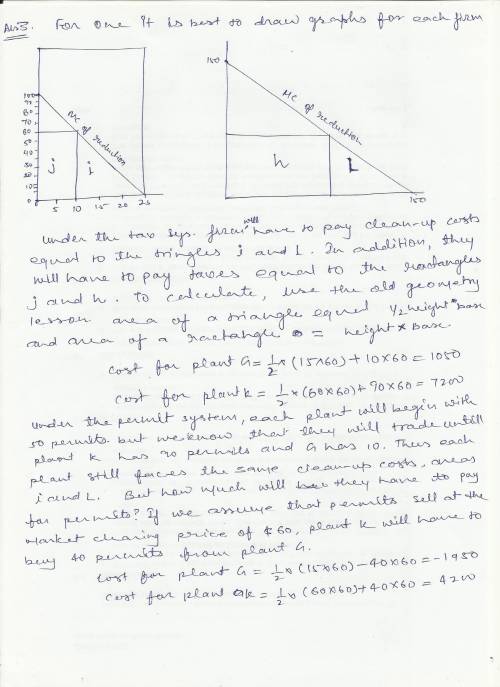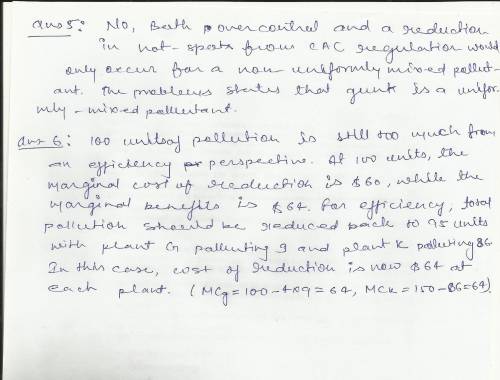
Two plants are emitting a uniformly mixed pollutant called gunk into the beautiful sky over tourist town. the city government decides it can tolerate total emissions of no more than 100 kg of gunk per day. plant g has marginal reduction costs of 100 - 4x and is currently polluting at a level of 25, while plant k has marginal reduction costs of 150 - y and currently pollutes at a level of 150 (x and y are the level of emissions at each plant).
1. what is the cost-effective pollution level for each plant if total pollution must equal 100? suppose the city government knows marginal reduction costs at the two plants. in this case, could the city obtain cost-effective pollution reduction using a cac approach? if so, how?
2. in reality, why might the city have a hard time getting this information?

Answers: 2
Another question on Business

Business, 21.06.2019 19:40
Which of the following actions is most likely to result in a decrease in the money supply? a. the required reserve ratio for banks is decreased. b. the discount rate on overnight loans is lowered. c. the federal reserve bank buys treasury bonds. d. the government sells a new batch of treasury bonds. 2b2t
Answers: 1

Business, 21.06.2019 19:50
The u.s. stock market has returned an average of about 9% per year since 1900. this return works out to a real return (i.e., adjusted for inflation) of approximately 6% per year. if you invest $100,000 and you earn 6% a year on it, how much real purchasing power will you have in 30 years?
Answers: 2

Business, 22.06.2019 03:00
Insurance companies have internal controls in place to protect assets, monitor the accuracy of accounting records and encourage operational efficiencies and adherence to policies. these internal controls are generally of two types: administrative controls and accounting controls. administrative controls are the policies and procedures that guide the daily actions of employees. accounting controls are the policies and procedures that delineate authorizations of financial transactions that are done, safeguard assets, and provide reports on the company’s financial status in a reliable and timely manner. internal controls should include both preventative and detective controls. the purpose of preventative controls is to stop problems and errors before they occur. detective controls identify problems after they have occurred. preventative controls are usually more effective at reducing problems, but they also tend to be more expensive. internal controls must be flexible to adjust for changes in laws and regulations in addition to adding new products or modifying current ones. companies must also do regular analyses to ensure that the benefits of implementing the controls are worth their costs. when concerned about paying unwarranted insurance claims which type of control would be useful?
Answers: 2

Business, 22.06.2019 19:40
Last year ann arbor corp had $155,000 of assets, $305,000 of sales, $20,000 of net income, and a debt-to-total-assets ratio of 37.5%. the new cfo believes a new computer program will enable it to reduce costs and thus raise net income to $33,000. assets, sales, and the debt ratio would not be affected. by how much would the cost reduction improve the roe? a. 11.51%b. 12.11%c. 12.75%d. 13.42%e. 14.09%
Answers: 3
You know the right answer?
Two plants are emitting a uniformly mixed pollutant called gunk into the beautiful sky over tourist...
Questions

Mathematics, 22.07.2020 20:01









Mathematics, 22.07.2020 20:01


Computers and Technology, 22.07.2020 20:01







Mathematics, 22.07.2020 20:01






